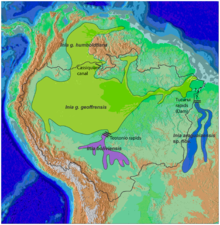
Back دلفين الأمازون Arabic دلفين الامازون ARZ Yaburol (Inia geoffrensis) AVK Amazon delfini Azerbaijani Амазонски речен делфин Bulgarian Dofí de l'Amazones Catalan Inia geoffrensis CEB Delfínovec amazonský Czech Amazonasdelfin German Δελφίνι του Αμαζονίου Greek
| Amazon river dolphin | |
|---|---|

| |

| |
| Size compared to an average human | |
| Scientific classification | |
| Domain: | Eukaryota |
| Kingdom: | Animalia |
| Phylum: | Chordata |
| Class: | Mammalia |
| Order: | Artiodactyla |
| Infraorder: | Cetacea |
| Family: | Iniidae |
| Genus: | Inia |
| Species: | I. geoffrensis
|
| Binomial name | |
| Inia geoffrensis (Blainville, 1817)
| |

| |
| Amazon river dolphin range | |
The Amazon river dolphin (Inia geoffrensis), also known as the boto, bufeo or pink river dolphin, is a species of toothed whale endemic to South America and is classified in the family Iniidae. Three subspecies are currently recognized: I. g. geoffrensis (Amazon river dolphin), I. g. boliviensis (Bolivian river dolphin) and I. g. humboldtiana (Orinoco river dolphin) while position of Araguaian river dolphin (I. araguaiaensis) within the clade is still unclear.[3][4] The three subspecies are distributed in the Amazon basin, the upper Madeira River in Bolivia, and the Orinoco basin, respectively.
The Amazon river dolphin is the largest species of river dolphin, with adult males reaching 185 kilograms (408 lb) in weight, and 2.5 metres (8.2 ft) in length. Adults acquire a pink color, more prominent in males, giving it its nickname "pink river dolphin". Sexual dimorphism is very evident, with males measuring 16% longer and weighing 55% more than females. Like other toothed whales, they have a melon, an organ that is used for bio sonar. The dorsal fin, although short in height, is regarded as long, and the pectoral fins are also large. The fin size, unfused vertebrae, and its relative size allow for improved manoeuvrability when navigating flooded forests and capturing prey.
They have one of the widest ranging diets among toothed whales, and feed on up to 53 different species of fish, such as croakers, catfish, tetras and piranhas. They also consume other animals such as river turtles, aquatic frogs, and freshwater crabs.[5]
In 2018, this species was ranked by the International Union for Conservation of Nature (IUCN) as endangered, with a declining population.[1] Threats include incidental catch in fishing lines, direct hunting for use as fish bait or predator control, damming, and pollution; as with many species, habitat loss and continued human development is becoming a greater threat.[1]
It is the only species of river dolphin kept in captivity, mainly in Venezuela and Europe. It is difficult to train and a high mortality rate is seen among captive individuals.
- ^ a b c da Silva, V.; Trujillo, F.; Martin, A.; Zerbini, A.N.; Crespo, E.; Aliaga-Rossel, E.; Reeves, R. (2018). "Inia geoffrensis". IUCN Red List of Threatened Species. 2018: e.T10831A50358152. doi:10.2305/IUCN.UK.2018-2.RLTS.T10831A50358152.en. Retrieved 12 November 2021.
- ^ "Appendices | CITES". cites.org. Retrieved 14 January 2022.
- ^ Hrbek, Tomas; Da Silva, Vera Maria Ferreira; Dutra, Nicole; Gravena, Waleska; Martin, Anthony R.; Farias, Izeni Pires (22 January 2014). Turvey, Samuel T. (ed.). "A New Species of River Dolphin from Brazil or: How Little Do We Know Our Biodiversity". PLOS One. 9 (1): e83623. Bibcode:2014PLoSO...983623H. doi:10.1371/journal.pone.0083623. PMC 3898917. PMID 24465386.
- ^ "List of Marine Mammal Species & Subspecies". Society for Marine Mammalogy. Archived from the original on 6 January 2015.
- ^ Cite error: The named reference
acswas invoked but never defined (see the help page).
© MMXXIII Rich X Search. We shall prevail. All rights reserved. Rich X Search
